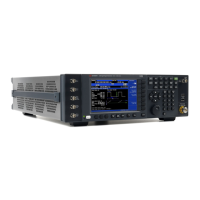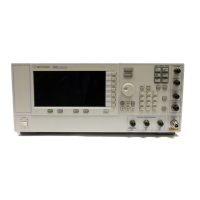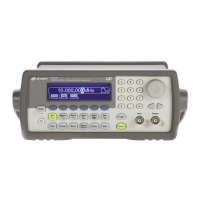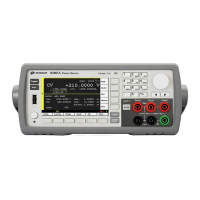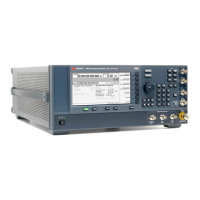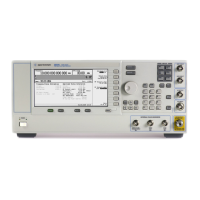What to do if Keysight Technologies N5183B MXG does not respond?
- AAntonio RamirezAug 19, 2025
If the Keysight Technologies Portable Generator does not respond, it might be in remote mode. Press the Local Cancel/(Esc) button to exit remote mode.

What to do if Keysight Technologies N5183B MXG does not respond?
If the Keysight Technologies Portable Generator does not respond, it might be in remote mode. Press the Local Cancel/(Esc) button to exit remote mode.
How to fix no RF output on Keysight Technologies N5183B MXG Portable Generator?
If there's no RF output from your Keysight Technologies Portable Generator, and the RF ON/OFF LED is off, press the RF On/Off button to activate the output. Also, ensure the amplitude is within the generator's specified range and that marker polarity and routing settings are correct if a waveform is playing.
How to troubleshoot low RF output power on Keysight Technologies N5183B MXG?
If the RF output power is too low on your Keysight Technologies Portable Generator and the AMPLITUDE area of the display shows the OFFS indicator, press Amptd > More 1 of 2 > Amptd Offset > 0 > dB. If the AMPLITUDE area shows the REF indicator, turn off the reference mode. If pulse modulation is on, turn off the ALC, and check that pulse width is within specifications.
Why is there no modulation at the RF output of my Keysight Technologies N5183B MXG Portable Generator?
If there is no modulation at the RF output of the Keysight Technologies Portable Generator, check the Mod On/Off LED and the Off On softkey to ensure both are on. Also, make sure that the internal I/Q modulator is on. If using an external modulation source, verify that the external source is on and operating within the signal generator’s specified limits.
How to turn off sweep on Keysight Technologies N5183B MXG?
To turn off sweep on the Keysight Technologies Portable Generator, press Sweep > Sweep > Off.
How to fix incorrect list sweep dwell time on Keysight Technologies Portable Generator?
To correct an incorrect list sweep dwell time on the Keysight Technologies Portable Generator, edit the dwell values. Also, ensure that the Dwell Type List Step softkey is set to List.
What to do if display turns black when using USB media on Keysight Technologies Portable Generator?
If the display turns black when using USB media with your Keysight Technologies Portable Generator, this might be caused by removing the USB media while the instrument is using it. Cycle the instrument power to resolve this.
Why does sweep appear stalled on my Keysight Technologies Portable Generator?
If the sweep appears stalled on your Keysight Technologies Portable Generator, check the current status of the sweep indicated in the progress bar. If the sweep is in single mode, press the Single Sweep softkey. If there is a missing sweep trigger, set Sweep Trigger to Free Run. If there is a missing point trigger, set Point Trigger to Free Run. If the dwell time was set incorrectly, set the dwell time to one second. If there are few points in the step sweep or list sweep, ensure that you set at least two points in the step sweep or list sweep.
What to do if Keysight Technologies N5183B MXG recognizes USB but does not display files?
If the Keysight Technologies Portable Generator recognizes the USB media connection but does not display files, the USB media may be incompatible. Try using a different USB media.
What to do if signal loss while working with a mixer and Keysight Technologies N5183B MXG Portable Generator?
If you are experiencing signal loss while working with a mixer and the Keysight Technologies Portable Generator, add attenuation and increase the RF output amplitude.
| Brand | Keysight Technologies |
|---|---|
| Model | N5183B MXG |
| Category | Portable Generator |
| Language | English |
Lists and describes various operating modes, including CW, swept, and modulation modes.
Describes selecting between Primary, BERT, or N5102A baseband operating modes.
Explains how to return the signal generator to a known state using Preset or User Preset keys.
Guides on setting frequency and amplitude using dedicated keys and softkeys.
Details configuring swept signal modes, including step and list sweeps.
Provides an overview of navigating file menus and managing files.
Explains how to read and interpret error messages reported by the signal generator.
Details using the dual power meter display to show frequency and power from sensors.
Describes using power meter readings to adjust output power and maintain constant DUT power.
Covers digital adjustment of RF output amplitude to compensate for external losses.
Describes the internal calibration routine for baseband and RF magnitude/phase errors.
Explains using external detectors to account for cabling and component uncertainties.
Provides a step-by-step guide to configuring pulse modulation.
Guides on storing, loading, and playing waveform segments using BBG media.
Covers using waveform markers to define points, control routing, and polarity.
Explains using FIR filters to refine transitions between symbol decision points.
Covers setting up master/slave systems for synchronizing waveform playback.
Explains licensing waveforms for unlimited playback and managing license slots.
Covers creating custom modulation using ARB Custom or Real-Time Custom modes.
Explains using FIR filters to refine transitions between symbol decision points.
Details creating unframed digital modulation with user-defined parameters.
Details creating multitone waveforms using the setup table editor.
Guides on defining and modifying user-defined two-tone waveforms.
Explains applying Additive White Gaussian Noise (AWGN) in real time to a dual ARB waveform.
Details controlling phase noise performance by setting frequency points and amplitude.
Covers DAC over-range errors and how scaling eliminates them.
Lets you open a menu to configure Real-Time Fading simulations.
Describes the VOR system for aircraft bearing information and its signal parameters.
Details the ILS localizer system for lateral/horizontal guidance to a runway.
Explains the ILS glide slope system for vertical descent path guidance to a runway.
Guides on setting the BERT baseband operating mode for digital communications analysis.
Details setting the N5102A baseband operating mode for digital signal interface module.
Explains setting the primary baseband operating mode for full feature support.
Covers performing bit error rate (BER) analysis on digital communications equipment.
Explains operating principles of triggering for Option UN7.
Provides procedures to verify BERT operation using self-test or custom modulation.
Describes clocking for digital data, including port configurations and phase/skew settings.
Covers troubleshooting for no RF output, power supply issues, modulation, and power levels.
Explains the types of errors detected by the instrument and their meaning.


